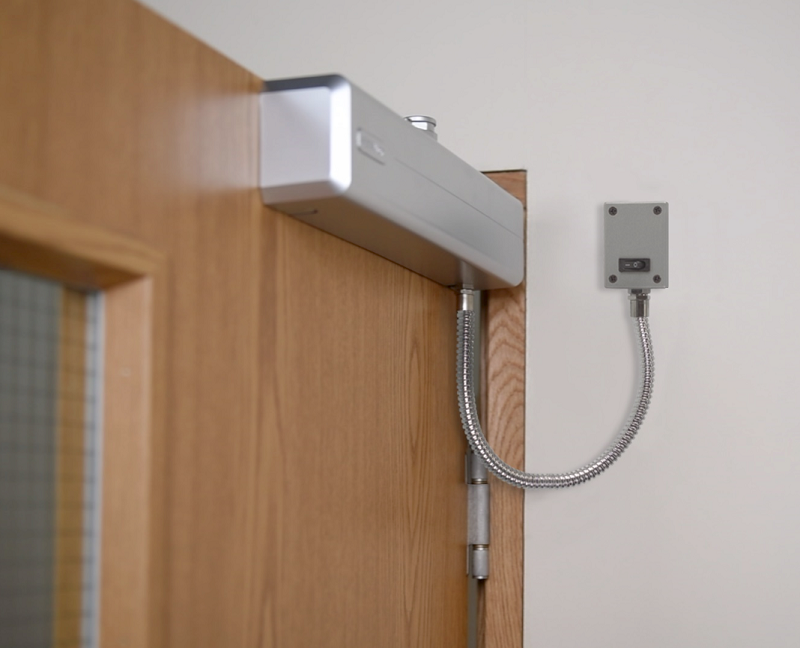With the UK poised for a possible second wave of coronavirus, the cleanliness of hospitals remains key to reducing the spread of the infection and ensuring the safety of patients and staff.
But, while environmental decontamination procedures are in place in healthcare facilities across the country in line with government and public health guidelines; there are some areas that need special attention.
Major touchpoints are particularly key, such as light switches, medical equipment, bedrails, drip stands and so on.
Another potential source of infection is, inevitably, door handles.
As one of the most-commonly-touched surfaces in a building, it is vital that a regular cleaning routine for door hardware is established
Andy Matthews, head of sales at HOPPE (UK), explains: “Within health and care settings, door handles, pushplates and touch pads can be touched by hundreds, or even thousands, of patients, staff, residents and visitors every day.
“This can quickly lead to the transmission of potentially-harmful pathogens from one person’s hand to another, and from one surface to another.”
Karen Trigg of Allegion UK adds: “With the elderly and ill being at a higher risk of developing severe health problems due to the spread of harmful viruses and bacteria, it’s imperative facilities are kept as safe and sterile as possible.
“Even before the viral pandemic, it was known that bacteria could remain active on common contact surfaces for days – including door handles and grabrails, transmitting from person to person.
“This poses an added challenge for facility managers.”
But there are measures that can be taken, both when specifying door hardware, and when it comes to disinfecting it.
Firstly, it is advisable, where possible, to install touch-free door opening solutions.
Depending on budget and requirement, available products include automated door operators that can be activated by a remote motion sensor, push pad, coded entry system, card swipe, or remote control device.
Coded, card swipe or remote systems activated by a fob have the added benefit of enabling access control and are particularly useful to restrict access to private or secure areas.
If push pads are used, touch-free or anti-bacterial-coated activation buttons will help to further reduce potential contamination.
These systems are particularly prevalent in sterile areas such as operating theatres and cleanrooms, but could see more widespread use as a result of the COVID-19 response.
Specifiers must ensure that whatever they decide to fit is legal and compliant with standards. If in doubt, speak to your architectural ironmonger or manufacturer for advice
Systems utilising arm and foot pulls are another easy and cost-effective solution that will help to limit the level of contact an individual has with the door.
However, in some instances, non-touch door openers may not be possible, or cost effective.
In this case, traditional products can be manufactured from materials with inbuilt anti-bacterial or anti-microbial properties, or alternatively they can be covered with a special coating that will give similar, often-lifelong, protection.
Copper products are also increasingly attractive to healthcare estates managers as the material is proven to reduce the risk of transmission of harmful pathogens.
“While products such as these cannot eliminate or kill all germs, they do provide an additional level of protection and can help to maintain better hygiene standards when people are present in large numbers,” said Matthews.
Trigg adds: “Antimicrobial coatings are specifically formulated to inhibit the growth of bacteria by interrupting cell multiplication and can go a long way in reducing the spread of bacteria.
“Embedded within the nylon during production, this cannot be washed away or wiped off and provides an effective and long-lasting defence, helping to prevent germ build-up and significantly reducing cross contamination from contact areas.
“Antimicrobial coatings are specifically formulated to inhibit the growth of bacteria by interrupting cell multiplication and can go a long way in reducing the spread of bacteria.
“Not only will it help contain the spread of germs and bacteria, but taking this step will help to secure your premises and leave you well prepared for the future.”
But Matthews advises caution when dealing with fire doors, with any products fully tested to meet BS EN 1634.

Many products are now manufactured with inbuilt anti-bacterial or anti-microbial properties, further helping to reduce the likelihood of bacteria surviving on the surface
He said: “Although it can be tempting to prop open fire doors to reduce contact with them, this poses a serious risk in the event of a fire and is also against the law,” he said.
“There are, however, some legal and compliant options available, such as electromagnetic hold-open units and the Dorgard, which can be used to hold open fire doors.
“These products will release the door automatically when a fire alarm sounds, allowing the fire door to close securely.
“Specifiers must ensure that whatever they decide to fit is legal and compliant with standards. If in doubt, speak to your architectural ironmonger or manufacturer for advice.”
ASSA ABLOY’s DC300G-HF is installed in many hospitals as it holds doors open in medium to high-traffic corridors, allowing people to pass through without touching the doors, but closing automatically in the event of a fire.
By considering the door hardware options available to them, decision-makers can help make sure buildings mitigate the risk of germs and stop the spread of infections, ensuring everyone feels as safe and comfortable as possible in these spaces
How door hardware is cleaned on a day-to-day, and currently even a minute-to-minute, basis is also crucial.

Products which hold doors open automatically are widely used to limit the number of people touching doors in high-traffic areas. Image courtesy of ASSA ABLOY
Richard Bromley, business development director of the ASSA ABLOY Door Hardware Group, explains: “As one of the most-commonly-touched surfaces in a building, it is vital that a regular cleaning routine for door hardware is established.
“Firstly, hardware should be cleaned with a mild, non-abrasive anti-bacterial detergent and water solution using a soft cloth. Then, using water and a soft cloth only, surfaces should be wiped to remove any remaining detergent residue. The treated surface should appear visibly wet then allowed to air dry.
“It’s important not to use bleach solutions in order to avoid corroding metal hardware, as well as high-alkaline cleaners, as these can damage both metals and plastics.
“We would also recommend cleaners typically used on bathroom fixtures are avoided, as these can potentially damage the protective finishes of many fittings.
“While it is impossible to take a ‘one-size-fits-all’ approach, and factors such as frequency of use and the levels of traffic passing through a door, as well as the security and safety requirements of a space, will all impact on what your cleaning schedule.
“But, ultimately, there’s no escaping the fact that a cleaning routine of some kind will have to be implemented.”
Offering advice to specifiers, Trigg told BBH: “As a facilities manager, it should be a continuous objective to ensure optimal health and safety for all people within your buildings and, no matter the size of the premises, especially in the current climate, you should be confident your facility is equipped to help prevent the spread of infection.
Bromely adds: “Budget and site requirements permitting, there are solutions available that can reduce the likelihood of these key touchpoints proving an issue.
Antimicrobial coatings are specifically formulated to inhibit the growth of bacteria by interrupting cell multiplication and can go a long way in reducing the spread of bacteria
“By considering the door hardware options available to them, decision-makers can help make sure buildings mitigate the risk of germs and stop the spread of infections, ensuring everyone feels as safe and comfortable as possible in these spaces.
As COVID-19 continues to dominate infection prevention and control discussions in hospitals, Matthews predicts that new door hardware solutions will continue to evolve, with sensor devices becoming increasingly popular.
He adds: “I think anti-bacterial materials and coatings will become more commonplace across all settings, and for an increasing number of products moving forwards.
